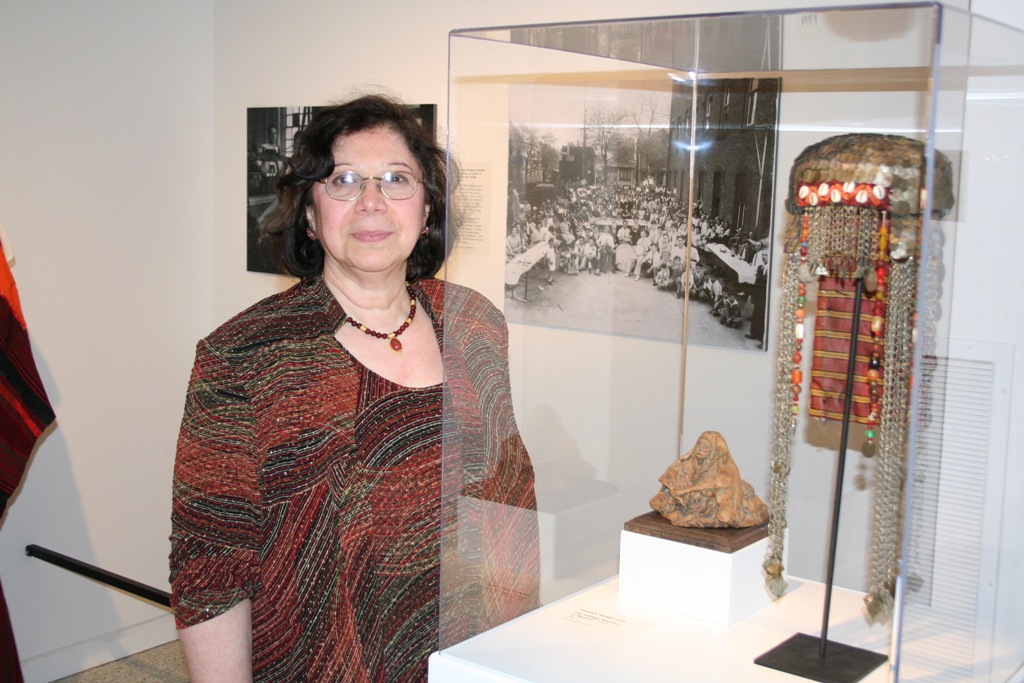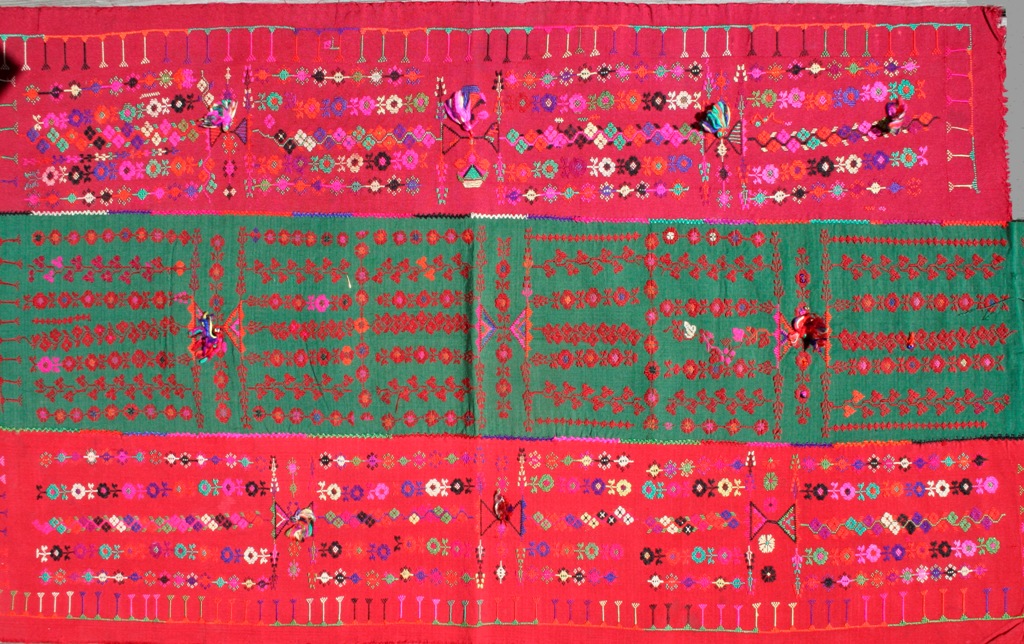Palestinian Heritage FoundationNewsletter of the Palestinian Heritage Foundation |
Selections from the Munayyer Collection on Display at the NJ State Museum
Culture in Context: A Tapestry of Expression is an exhibit presented by the New Jersey State Museum, consisting of various sections each representing a different ethnic group residing in New Jersey. The exhibit opening reception was attended by more than 400 guests including many senior officials from the State Government. Culture in Context is co-sponsored by the New Jersey State Council on the Arts, and New Jersey Network Public Television and Radio. This exhibition was made possible in part by a grant from the New Jersey Council for the Humanities and the National Endowment for the Arts, which believes that “a great nation deserves great art.”
In 2004 Randa Munayyer received the below letter from the New Jersey State Council on the Arts. The Award prompted the invitation to the Palestinian Heritage Foundation to contribute Palestinian art and costumes towards the exhibit.
Dear Ms. Munayyer
Congratulations! The New Jersey State Council on the Arts is pleased to inform you that you have been awarded a Folk Arts Apprenticeship grant. Your application was reviewed by a panel of folk cultural specialists and was determined to be among the best in meeting the criteria for this grant program.
The panel found Mrs. Hanan Munayyer to be an excellent master of traditional Palestinian Embroidery and Craft and found you to be well prepared for and committed to developing your skills in this art form.
Culture in Context: A Tapestry of Expression
New Jersey State Museum
Trenton, New Jersey
This exhibition welcomes you to the homes, work places and community spaces of dozens of New Jersey residents whose skills in traditional arts weave the past into the present and create a tapestry rich with meaning and beauty. Their traditions may be shaped by ethnic or religious heritage, by the resources and industries of a regional environment, or by occupation, gender or age group. Whether music and dance, food ways, home decoration, clothing, practical crafts, rituals, or holiday and only day customs, each artistic expression is a symbolic story. It extends beyond the artist to include the history, values and beliefs of the artist’s community.
 The artists featured in this exhibition have participated in the Folk Arts Apprenticeship Grant Program of the New Jersey State Council on the Arts. These grants support apprentices as they perfect their skills in traditional arts under the watchful eyes of master artists from their communities. The traditions strengthen community life and, in turn, fortify the broader society.
The artists featured in this exhibition have participated in the Folk Arts Apprenticeship Grant Program of the New Jersey State Council on the Arts. These grants support apprentices as they perfect their skills in traditional arts under the watchful eyes of master artists from their communities. The traditions strengthen community life and, in turn, fortify the broader society.
Although only a small number of the 150 artists who have received these grants are included here and in performances and residencies throughout the run of the exhibition, many more such dedicated artists are all around us, often working without recognition to keep traditions alive in homes, workplaces and communities. Each of them is a curator of the culture. We hope that they inspire you to recognize, value and strengthen your own cultural traditions, and provide an opportunity for a new appreciation of the traditions of others. Together, we all weave the tapestry of New Jersey folk life.
Palestinian Embroidery

“Embroidery is a women’s art that tells women’s history.” Hanan Munayyer
Textile arts are probably, along with food ways, the most prevalent women’s art across cultures. Women have knit, sewn, woven, embroidered, patched and pieced their own and their families’ histories onto the tapestry of time. For Hanan Munayyer, embroidery patterns are a kind of script that have allowed women, regardless of their education, to express their creativity and
demonstrate their mastery of a traditional repertoire.
Munayyer grew up in Haifa, and like most Palestinian girls, learned the traditional embroidery of the family’s ancestral home
in Galilee from her mother at an early age. Its elaborate designs are created principally through cross-stitch and coughing. Couching has been called a “drawing stitch’ because it is often used to outline a design by over-sewing a heavier thread with a finer one. The specific designs communicate a woman’s marital status and her family’s economic and social status.
The crowning achievement of a young Palestinian woman’s skills is her wedding dress, which she begins embroidering years before she marries. Recognizing this, Hanan and her husband Farah began collecting antique wedding dresses in the 1980s and have used them an the centerpiece of their work in educating the public about traditional Palestinian culture. Their collection tells the story of Palestinian women’s history in several ways. It documents the artistic achievement of dozens of young women and embodies their social experience as a group. Further, it represents the cultural journey of Hanan from her Palestinian homeland to America, and her dedication to both preserving the tradition and sharing its story.
Though Hanan did not make a traditional embroidered dress for her marriage, she has incorporated the traditional stitchery into her life in other ways. In her home, framed elements of traditional costumes – a headdress, the yoke of a gown – grace the walls as artworks. Hanan decorates pillows, scarves, jackets and dresses with the traditional designs of her family’s ancestral home. Her daughters’ have learned the craft from her to continue the history of Palestinian women into the Diaspora.
Displayed also at the exhibit is a sculpture of a “Village Woman at the Marketplace”, sculpted by Hanan in 1973.
Rima Bordcosh donates dress to Foundation
Ms. Rima Bordcosh became a friend and supporter of the Palestinian Heritage Foundation in the early 1990s after attending a live performance by the Foundation at the United Nations in New York were she worked. Since then, Rima and her sister Leila have attended almost all PHF activities including the most recent banquet held in April 2007 to celebrate the Foundation’s twentieth anniversary.
Last November, Rima and Leila were among 450 guests who attended the opening reception to the exhibit Palestine: A Continuing Legacy presented by the Foundation at the United Nations in New York to commemorate the Day of Solidarity with the Palestinian People. To express her admiration for the display and further demonstrate her support for PHF’s activities, Rima decided to donate the only antique Palestinian costume she owns to the Foundation. The dress is made of black velvet fabric with orange and red silk panels embroidered with Bethlehem couching stitch attached to the sleeves, sides, and chestpiece. This style of dress used to be worn by Palestinian women in the Ein Karem and Malha villages around Jerusalem.
When asked how she came to own the dress, Rima wrote: “I visited Jordan in 1976. While I was there I felt drawn closer to Palestine and wanted to fulfill a desire that I always wanted: to own Palestinian National dresses and to wear them and to say loud and clear — this is part of our inheritance and heritage, a part that was also stolen from us. I went to the Bakaa refugee camp in Amman with a recommendation from a friend. I visited an elderly Palestinian lady and she showed me several dresses. I chose the one I am contributing to your organization. I grabbed it . It was good on me and the owner explained its history. It apparently was woven and worn in the Jerusalem area the beginning of the twentieth century. And it exchanged hands from mother to daughter to grand daughter. What I liked most about it is that it displays the Tree of Life, that signifies the Palestinian Just Struggle and right to a dignified life. I loved it and I bought it. I took care of it as if it was part of me, a part of Palestine.”
Both Rima and Leila were born in Jaffa, Palestine, Farah’s hometown and place of birth. In addition, Farah’s father, Joseph Munayyer, a pharmacist, used to work with Rima’s uncle, Atallah Bordcosh, also a pharmacist who owned the largest pharmacy in downtown Jaffa during the 1930s. What a small world !!!
Thank you Rima for this generous contribution.
Foundation Acquire Additional Antique Garments
The Foundation has recently acquired a collection of Palestinian embroidered pillow cases dating back to the early twentieth century. These items were purchased in Palestine in the early 1970s by a British subject assigned to the United Nation’s Mission to Jerusalem. The pillows come from the regions of El Khalil, Masmiyyeh and Majdal.
Two Iraqiyeh Headdresses Added to Collection
Two Iraqiyeh headdresses from the El Khalil region were recently purchased and added to the Foundation’s collection. Both items were acquired through a dealer.
PHF Mail……….
Dears,
I got your website from a friend in the US. What you do is an extremely great job . This is one of the basic steps that Palestinians, as a people with such an impressive heritage must encourage. To make other nations familiar with our traditional costumes is a universal step that must be a strategy adopted by the Palestinian Authority. You have achieved in the interest of Palestinian culture what the PA and its cultural institutions have never ever regarded or paid any least attention to. To have my original heritage in one of the 50 States is a great honor for me as a Palestinian woman. God Bless You.
Many thanks,
Reem Wishah, Gaza, Palestine
Dear Hanan and Farah,
Again I have to say that it’s my pleasure to deal with you and thank you very much for your information about Palestinian costumes at the web site which is really impressive, and I am so proud that we have people like you who still work on it. Well done, it is really good work and I wish as a Palestinian I can do the same kind of work here in Doha to tell people what are the Palestinian costumes and how they are so beautiful and unique. For your information I am one of these ladies who is teaching our Palestinian Embroidery at Virginia Commonwealth University in Qatar part time in a community classes.
Wish you all the best,
Maha Kassab
Doha, Qatar















